warning light NISSAN LEAF 2022 Owner´s Manual
[x] Cancel search | Manufacturer: NISSAN, Model Year: 2022, Model line: LEAF, Model: NISSAN LEAF 2022Pages: 618, PDF Size: 4.3 MB
Page 143 of 618
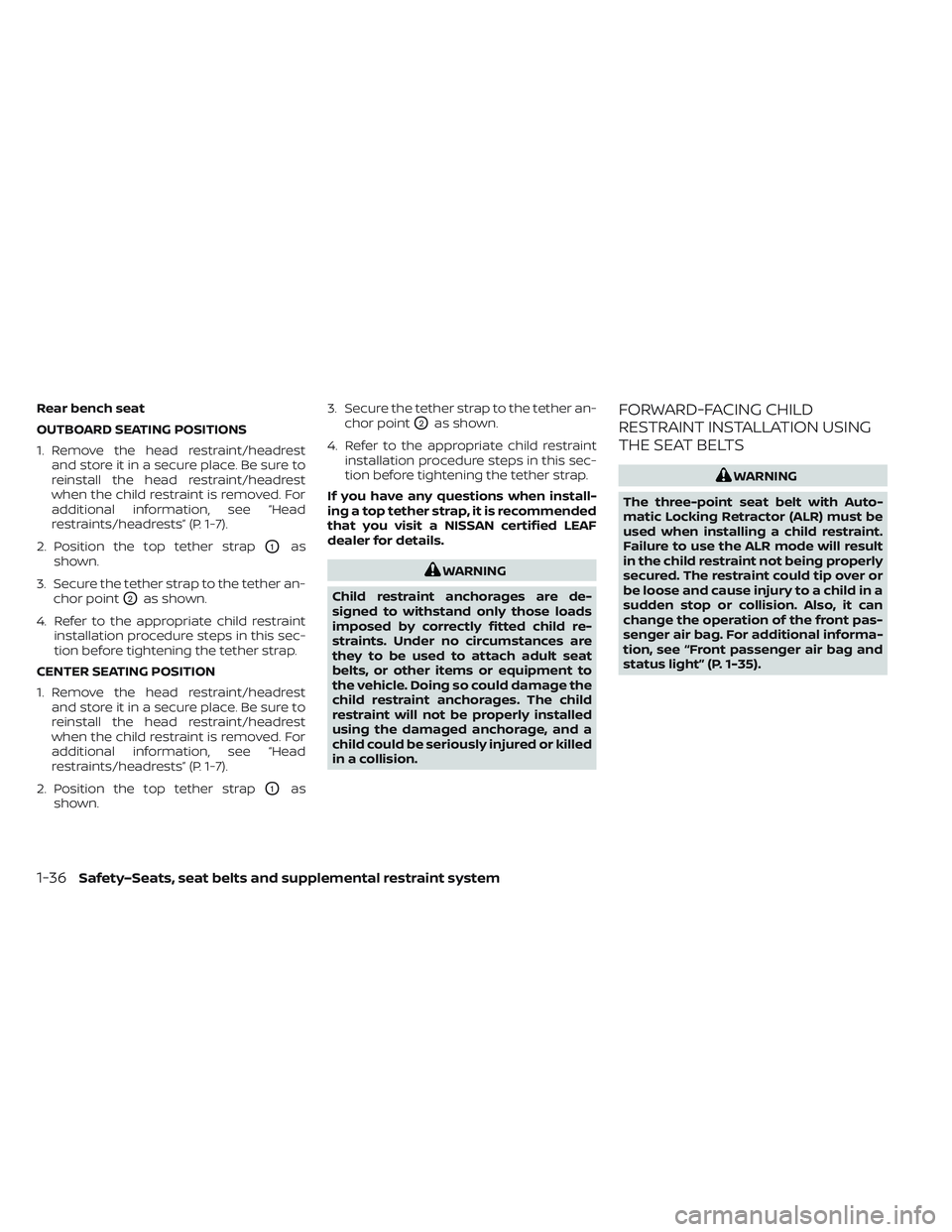
Rear bench seat
OUTBOARD SEATING POSITIONS
1. Remove the head restraint/headrestand store it in a secure place. Be sure to
reinstall the head restraint/headrest
when the child restraint is removed. For
additional information, see “Head
restraints/headrests” (P. 1-7).
2. Position the top tether strap
O1as
shown.
3. Secure the tether strap to the tether an- chor point
O2as shown.
4. Refer to the appropriate child restraint installation procedure steps in this sec-
tion before tightening the tether strap.
CENTER SEATING POSITION
1. Remove the head restraint/headrest and store it in a secure place. Be sure to
reinstall the head restraint/headrest
when the child restraint is removed. For
additional information, see “Head
restraints/headrests” (P. 1-7).
2. Position the top tether strap
O1as
shown. 3. Secure the tether strap to the tether an-
chor point
O2as shown.
4. Refer to the appropriate child restraint installation procedure steps in this sec-
tion before tightening the tether strap.
If you have any questions when install-
ing a top tether strap, it is recommended
that you visit a NISSAN certified LEAF
dealer for details.
WARNING
Child restraint anchorages are de-
signed to withstand only those loads
imposed by correctly fitted child re-
straints. Under no circumstances are
they to be used to attach adult seat
belts, or other items or equipment to
the vehicle. Doing so could damage the
child restraint anchorages. The child
restraint will not be properly installed
using the damaged anchorage, and a
child could be seriously injured or killed
in a collision.
FORWARD-FACING CHILD
RESTRAINT INSTALLATION USING
THE SEAT BELTS
WARNING
The three-point seat belt with Auto-
matic Locking Retractor (ALR) must be
used when installing a child restraint.
Failure to use the ALR mode will result
in the child restraint not being properly
secured. The restraint could tip over or
be loose and cause injury to a child in a
sudden stop or collision. Also, it can
change the operation of the front pas-
senger air bag. For additional informa-
tion, see “Front passenger air bag and
status light” (P. 1-35).
1-36Safety–Seats, seat belts and supplemental restraint system
Page 151 of 618
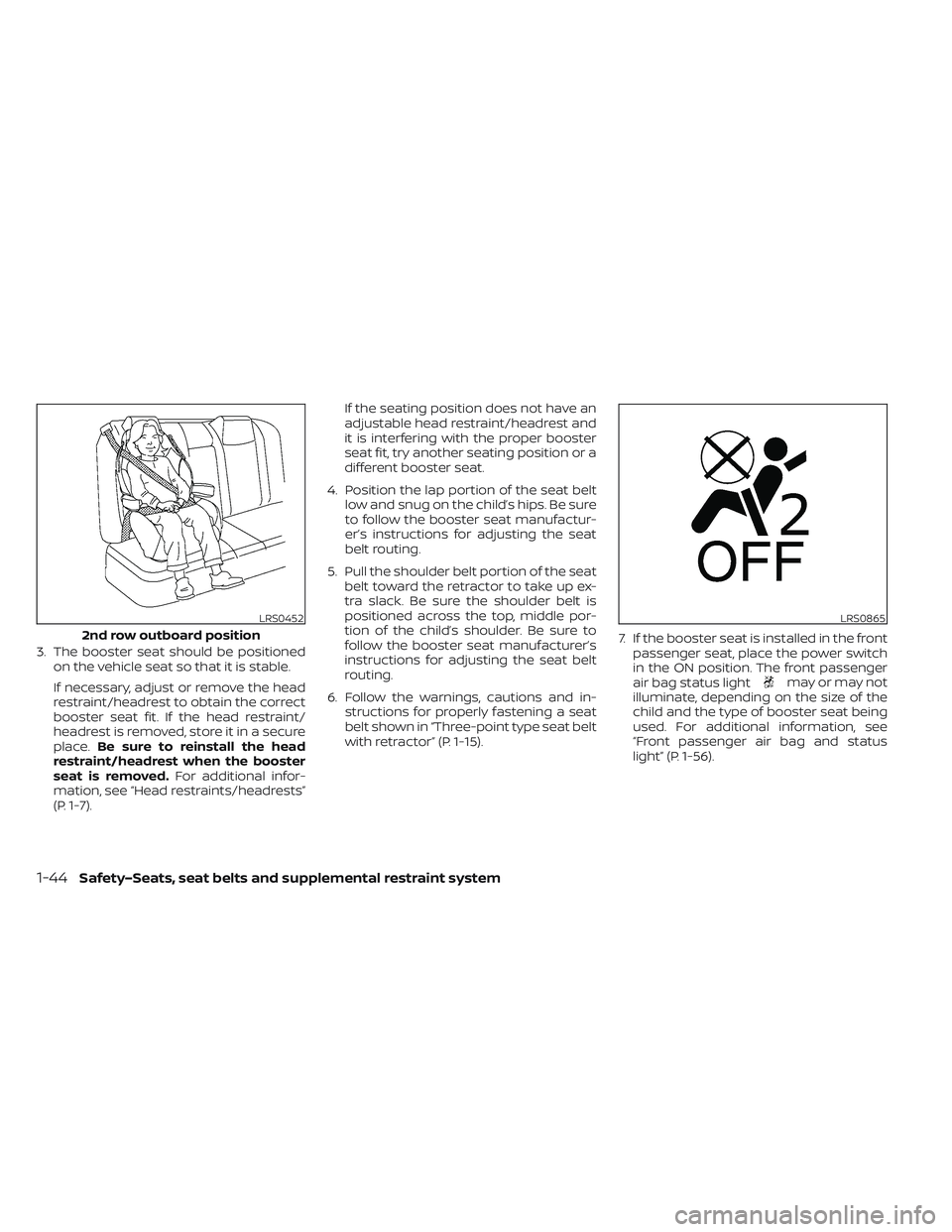
3. The booster seat should be positionedon the vehicle seat so that it is stable.
If necessary, adjust or remove the head
restraint/headrest to obtain the correct
booster seat fit. If the head restraint/
headrest is removed, store it in a secure
place. Be sure to reinstall the head
restraint/headrest when the booster
seat is removed. For additional infor-
mation, see “Head restraints/headrests”
(P. 1-7). If the seating position does not have an
adjustable head restraint/headrest and
it is interfering with the proper booster
seat fit, try another seating position or a
different booster seat.
4. Position the lap portion of the seat belt low and snug on the child’s hips. Be sure
to follow the booster seat manufactur-
er’s instructions for adjusting the seat
belt routing.
5. Pull the shoulder belt portion of the seat belt toward the retractor to take up ex-
tra slack. Be sure the shoulder belt is
positioned across the top, middle por-
tion of the child’s shoulder. Be sure to
follow the booster seat manufacturer’s
instructions for adjusting the seat belt
routing.
6. Follow the warnings, cautions and in- structions for properly fastening a seat
belt shown in “Three-point type seat belt
with retractor” (P. 1-15). 7. If the booster seat is installed in the front
passenger seat, place the power switch
in the ON position. The front passenger
air bag status light
may or may not
illuminate, depending on the size of the
child and the type of booster seat being
used. For additional information, see
“Front passenger air bag and status
light” (P. 1-56).
LRS0452
2nd row outboard position
LRS0865
1-44Safety–Seats, seat belts and supplemental restraint system
Page 152 of 618
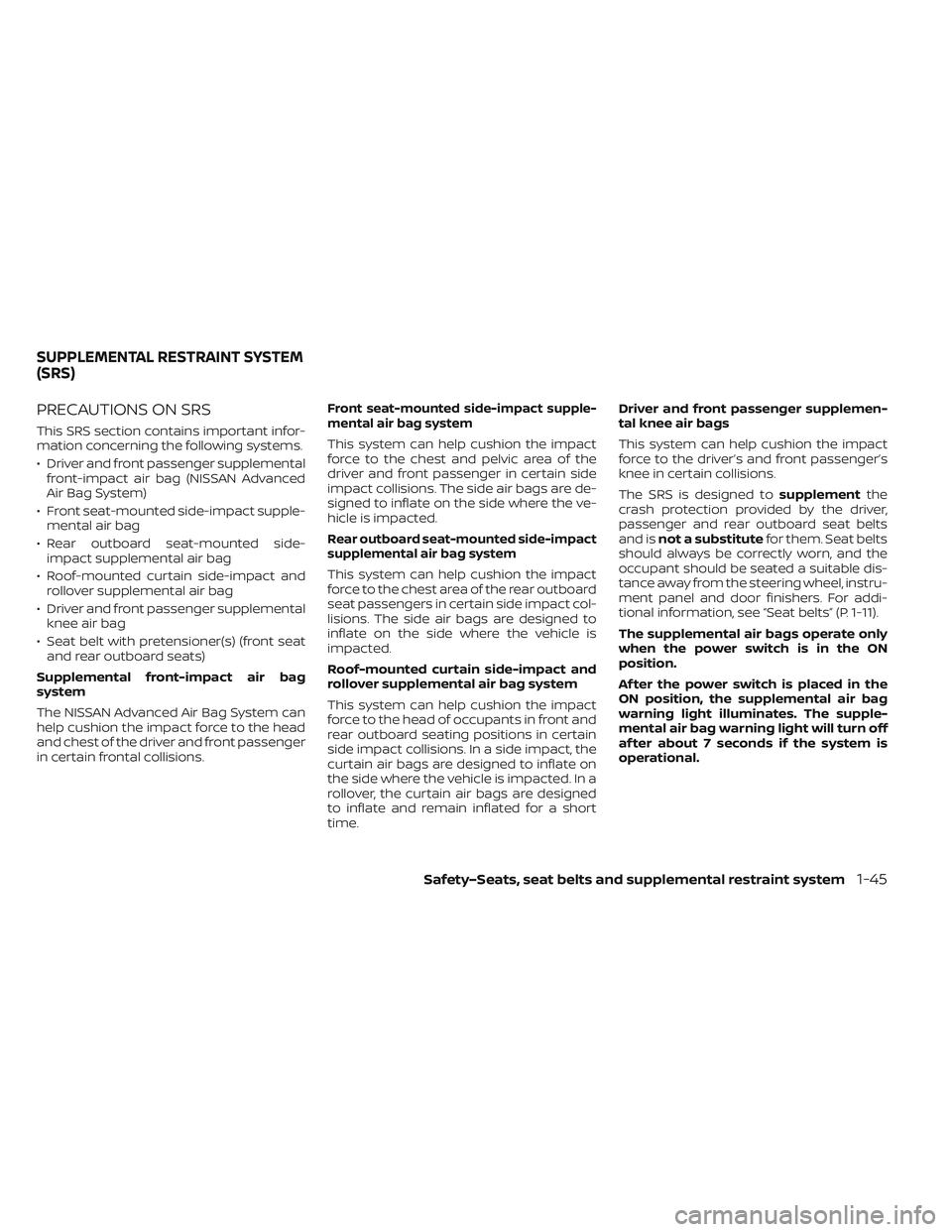
PRECAUTIONS ON SRS
This SRS section contains important infor-
mation concerning the following systems.
• Driver and front passenger supplementalfront-impact air bag (NISSAN Advanced
Air Bag System)
• Front seat-mounted side-impact supple- mental air bag
• Rear outboard seat-mounted side- impact supplemental air bag
• Roof-mounted curtain side-impact and rollover supplemental air bag
• Driver and front passenger supplemental knee air bag
• Seat belt with pretensioner(s) (front seat and rear outboard seats)
Supplemental front-impact air bag
system
The NISSAN Advanced Air Bag System can
help cushion the impact force to the head
and chest of the driver and front passenger
in certain frontal collisions.
Front seat-mounted side-impact supple-
mental air bag system
This system can help cushion the impact
force to the chest and pelvic area of the
driver and front passenger in certain side
impact collisions. The side air bags are de-
signed to inflate on the side where the ve-
hicle is impacted.
Rear outboard seat-mounted side-impact
supplemental air bag system
This system can help cushion the impact
force to the chest area of the rear outboard
seat passengers in certain side impact col-
lisions. The side air bags are designed to
inflate on the side where the vehicle is
impacted.
Roof-mounted curtain side-impact and
rollover supplemental air bag system
This system can help cushion the impact
force to the head of occupants in front and
rear outboard seating positions in certain
side impact collisions. In a side impact, the
curtain air bags are designed to inflate on
the side where the vehicle is impacted. In a
rollover, the curtain air bags are designed
to inflate and remain inflated for a short
time. Driver and front passenger supplemen-
tal knee air bags
This system can help cushion the impact
force to the driver’s and front passenger’s
knee in certain collisions.
The SRS is designed to
supplementthe
crash protection provided by the driver,
passenger and rear outboard seat belts
and is not a substitute for them. Seat belts
should always be correctly worn, and the
occupant should be seated a suitable dis-
tance away from the steering wheel, instru-
ment panel and door finishers. For addi-
tional information, see “Seat belts” (P. 1-11).
The supplemental air bags operate only
when the power switch is in the ON
position.
Af ter the power switch is placed in the
ON position, the supplemental air bag
warning light illuminates. The supple-
mental air bag warning light will turn off
af ter about 7 seconds if the system is
operational.
SUPPLEMENTAL RESTRAINT SYSTEM
(SRS)
Safety–Seats, seat belts and supplemental restraint system1-45
Page 154 of 618
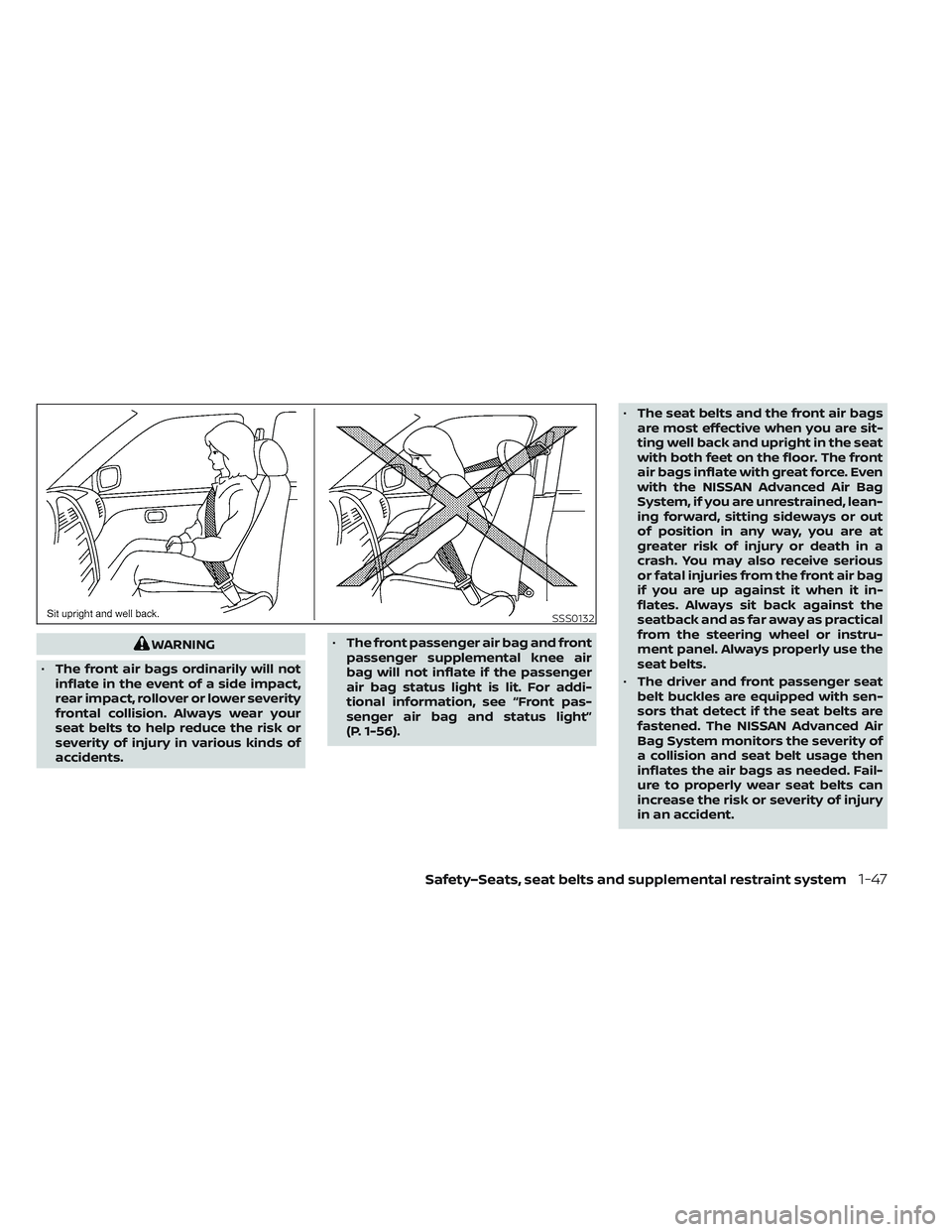
WARNING
• The front air bags ordinarily will not
inflate in the event of a side impact,
rear impact, rollover or lower severity
frontal collision. Always wear your
seat belts to help reduce the risk or
severity of injury in various kinds of
accidents. •
The front passenger air bag and front
passenger supplemental knee air
bag will not inflate if the passenger
air bag status light is lit. For addi-
tional information, see “Front pas-
senger air bag and status light”
(P. 1-56). •
The seat belts and the front air bags
are most effective when you are sit-
ting well back and upright in the seat
with both feet on the floor. The front
air bags inflate with great force. Even
with the NISSAN Advanced Air Bag
System, if you are unrestrained, lean-
ing forward, sitting sideways or out
of position in any way, you are at
greater risk of injury or death in a
crash. You may also receive serious
or fatal injuries from the front air bag
if you are up against it when it in-
flates. Always sit back against the
seatback and as far away as practical
from the steering wheel or instru-
ment panel. Always properly use the
seat belts.
• The driver and front passenger seat
belt buckles are equipped with sen-
sors that detect if the seat belts are
fastened. The NISSAN Advanced Air
Bag System monitors the severity of
a collision and seat belt usage then
inflates the air bags as needed. Fail-
ure to properly wear seat belts can
increase the risk or severity of injury
in an accident.
SSS0132
Safety–Seats, seat belts and supplemental restraint system1-47
Page 161 of 618
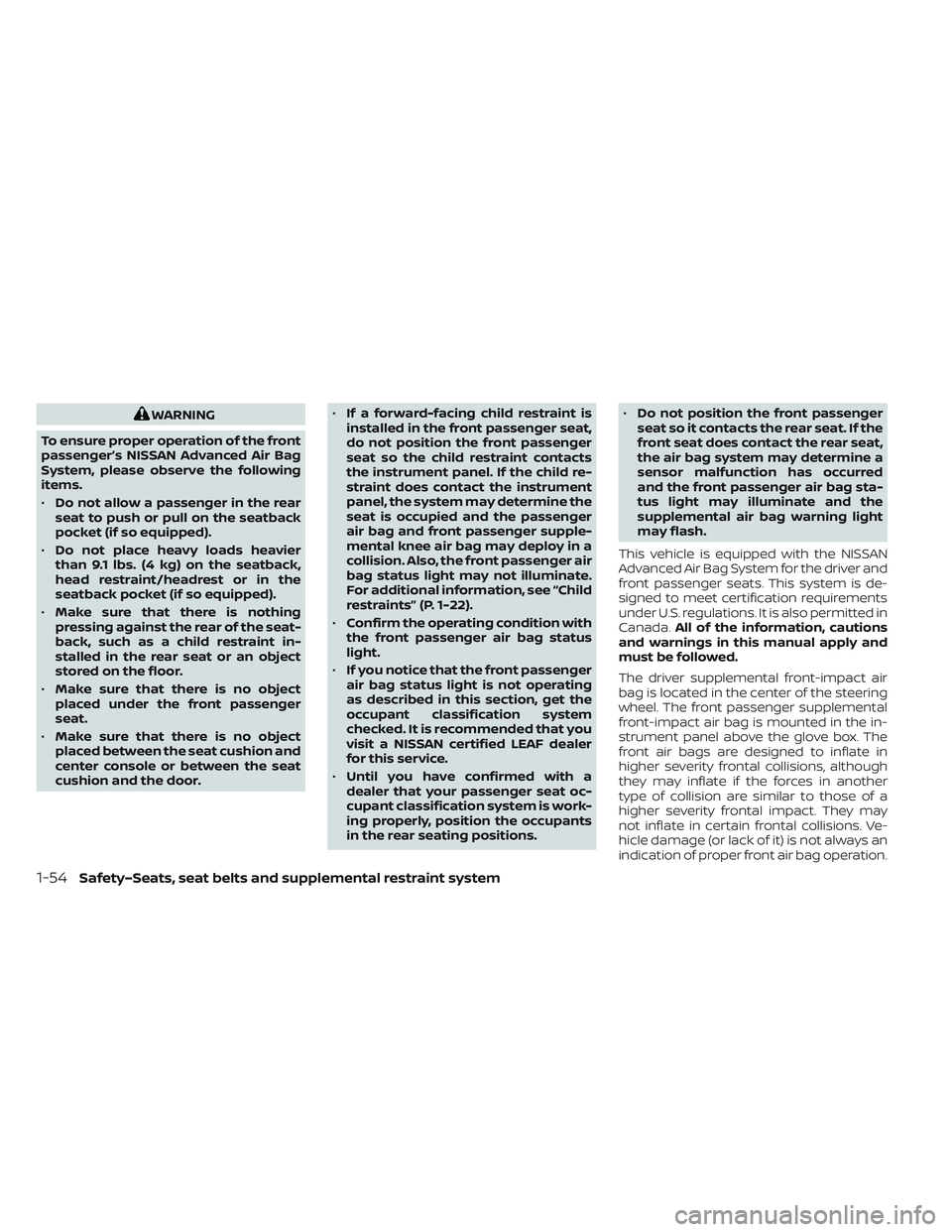
WARNING
To ensure proper operation of the front
passenger’s NISSAN Advanced Air Bag
System, please observe the following
items.
• Do not allow a passenger in the rear
seat to push or pull on the seatback
pocket (if so equipped).
• Do not place heavy loads heavier
than 9.1 lbs. (4 kg) on the seatback,
head restraint/headrest or in the
seatback pocket (if so equipped).
• Make sure that there is nothing
pressing against the rear of the seat-
back, such as a child restraint in-
stalled in the rear seat or an object
stored on the floor.
• Make sure that there is no object
placed under the front passenger
seat.
• Make sure that there is no object
placed between the seat cushion and
center console or between the seat
cushion and the door. •
If a forward-facing child restraint is
installed in the front passenger seat,
do not position the front passenger
seat so the child restraint contacts
the instrument panel. If the child re-
straint does contact the instrument
panel, the system may determine the
seat is occupied and the passenger
air bag and front passenger supple-
mental knee air bag may deploy in a
collision. Also, the front passenger air
bag status light may not illuminate.
For additional information, see “Child
restraints” (P. 1-22).
• Confirm the operating condition with
the front passenger air bag status
light.
• If you notice that the front passenger
air bag status light is not operating
as described in this section, get the
occupant classification system
checked. It is recommended that you
visit a NISSAN certified LEAF dealer
for this service.
• Until you have confirmed with a
dealer that your passenger seat oc-
cupant classification system is work-
ing properly, position the occupants
in the rear seating positions. •
Do not position the front passenger
seat so it contacts the rear seat. If the
front seat does contact the rear seat,
the air bag system may determine a
sensor malfunction has occurred
and the front passenger air bag sta-
tus light may illuminate and the
supplemental air bag warning light
may flash.
This vehicle is equipped with the NISSAN
Advanced Air Bag System for the driver and
front passenger seats. This system is de-
signed to meet certification requirements
under U.S. regulations. It is also permitted in
Canada. All of the information, cautions
and warnings in this manual apply and
must be followed.
The driver supplemental front-impact air
bag is located in the center of the steering
wheel. The front passenger supplemental
front-impact air bag is mounted in the in-
strument panel above the glove box. The
front air bags are designed to inflate in
higher severity frontal collisions, although
they may inflate if the forces in another
type of collision are similar to those of a
higher severity frontal impact. They may
not inflate in certain frontal collisions. Ve-
hicle damage (or lack of it) is not always an
indication of proper front air bag operation.
1-54Safety–Seats, seat belts and supplemental restraint system
Page 162 of 618
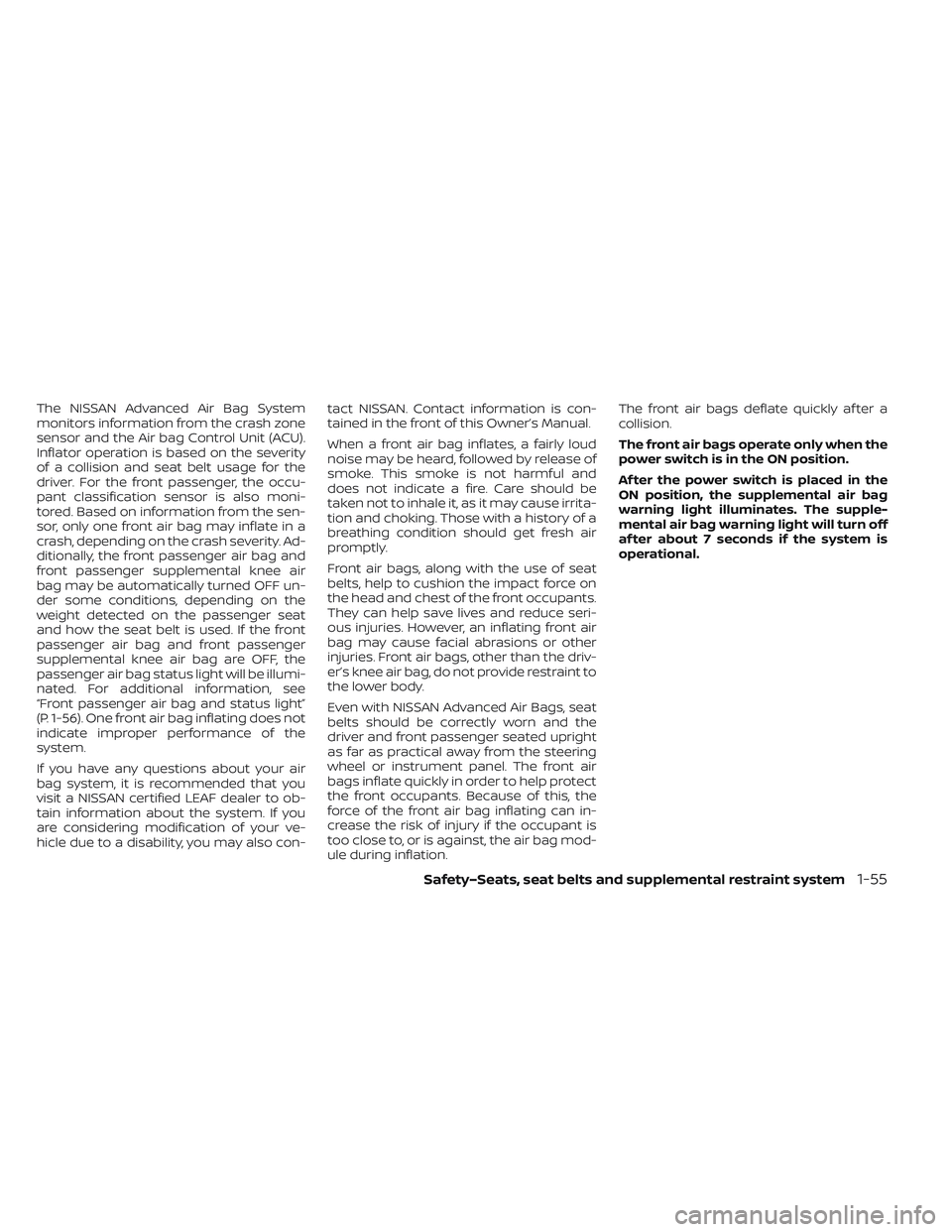
The NISSAN Advanced Air Bag System
monitors information from the crash zone
sensor and the Air bag Control Unit (ACU).
Inflator operation is based on the severity
of a collision and seat belt usage for the
driver. For the front passenger, the occu-
pant classification sensor is also moni-
tored. Based on information from the sen-
sor, only one front air bag may inflate in a
crash, depending on the crash severity. Ad-
ditionally, the front passenger air bag and
front passenger supplemental knee air
bag may be automatically turned OFF un-
der some conditions, depending on the
weight detected on the passenger seat
and how the seat belt is used. If the front
passenger air bag and front passenger
supplemental knee air bag are OFF, the
passenger air bag status light will be illumi-
nated. For additional information, see
“Front passenger air bag and status light”
(P. 1-56). One front air bag inflating does not
indicate improper performance of the
system.
If you have any questions about your air
bag system, it is recommended that you
visit a NISSAN certified LEAF dealer to ob-
tain information about the system. If you
are considering modification of your ve-
hicle due to a disability, you may also con-tact NISSAN. Contact information is con-
tained in the front of this Owner’s Manual.
When a front air bag inflates, a fairly loud
noise may be heard, followed by release of
smoke. This smoke is not harmful and
does not indicate a fire. Care should be
taken not to inhale it, as it may cause irrita-
tion and choking. Those with a history of a
breathing condition should get fresh air
promptly.
Front air bags, along with the use of seat
belts, help to cushion the impact force on
the head and chest of the front occupants.
They can help save lives and reduce seri-
ous injuries. However, an inflating front air
bag may cause facial abrasions or other
injuries. Front air bags, other than the driv-
er’s knee air bag, do not provide restraint to
the lower body.
Even with NISSAN Advanced Air Bags, seat
belts should be correctly worn and the
driver and front passenger seated upright
as far as practical away from the steering
wheel or instrument panel. The front air
bags inflate quickly in order to help protect
the front occupants. Because of this, the
force of the front air bag inflating can in-
crease the risk of injury if the occupant is
too close to, or is against, the air bag mod-
ule during inflation.The front air bags deflate quickly af ter a
collision.
The front air bags operate only when the
power switch is in the ON position.
Af ter the power switch is placed in the
ON position, the supplemental air bag
warning light illuminates. The supple-
mental air bag warning light will turn off
af ter about 7 seconds if the system is
operational.
Safety–Seats, seat belts and supplemental restraint system1-55
Page 163 of 618
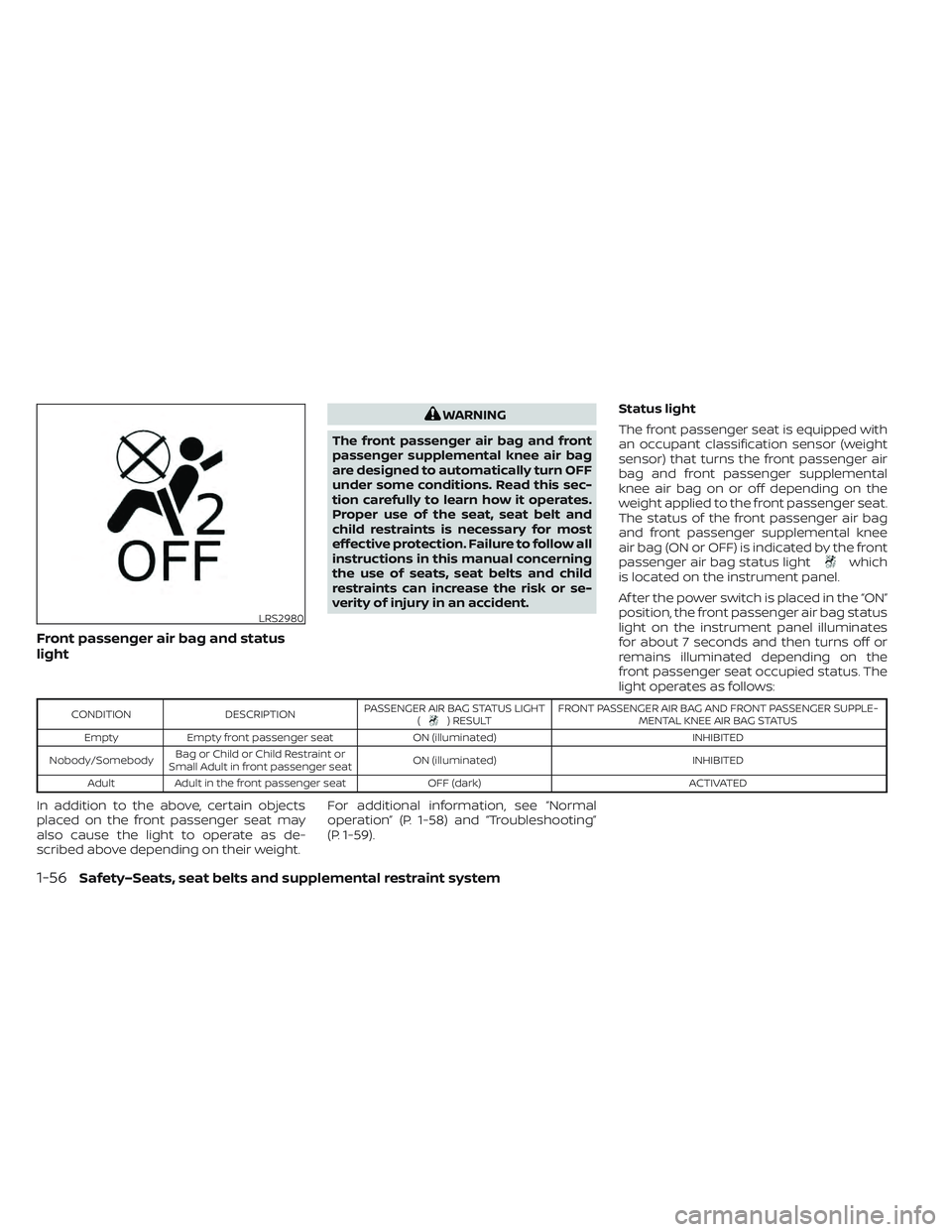
Front passenger air bag and status
light
WARNING
The front passenger air bag and front
passenger supplemental knee air bag
are designed to automatically turn OFF
under some conditions. Read this sec-
tion carefully to learn how it operates.
Proper use of the seat, seat belt and
child restraints is necessary for most
effective protection. Failure to follow all
instructions in this manual concerning
the use of seats, seat belts and child
restraints can increase the risk or se-
verity of injury in an accident. Status light
The front passenger seat is equipped with
an occupant classification sensor (weight
sensor) that turns the front passenger air
bag and front passenger supplemental
knee air bag on or off depending on the
weight applied to the front passenger seat.
The status of the front passenger air bag
and front passenger supplemental knee
air bag (ON or OFF) is indicated by the front
passenger air bag status light
which
is located on the instrument panel.
Af ter the power switch is placed in the “ON”
position, the front passenger air bag status
light on the instrument panel illuminates
for about 7 seconds and then turns off or
remains illuminated depending on the
front passenger seat occupied status. The
light operates as follows:
CONDITION DESCRIPTIONPASSENGER AIR BAG STATUS LIGHT
() RESULT FRONT PASSENGER AIR BAG AND FRONT PASSENGER SUPPLE-
MENTAL KNEE AIR BAG STATUS
Empty Empty front passenger seat ON (illuminated) INHIBITED
Nobody/Somebody Bag or Child or Child Restraint or
Small Adult in front passenger seat ON (illuminated)
INHIBITED
Adult Adult in the front passenger seat OFF (dark) ACTIVATED
In addition to the above, certain objects
placed on the front passenger seat may
also cause the light to operate as de-
scribed above depending on their weight.For additional information, see “Normal
operation” (P. 1-58) and “Troubleshooting”
(P. 1-59).
LRS2980
1-56Safety–Seats, seat belts and supplemental restraint system
Page 165 of 618
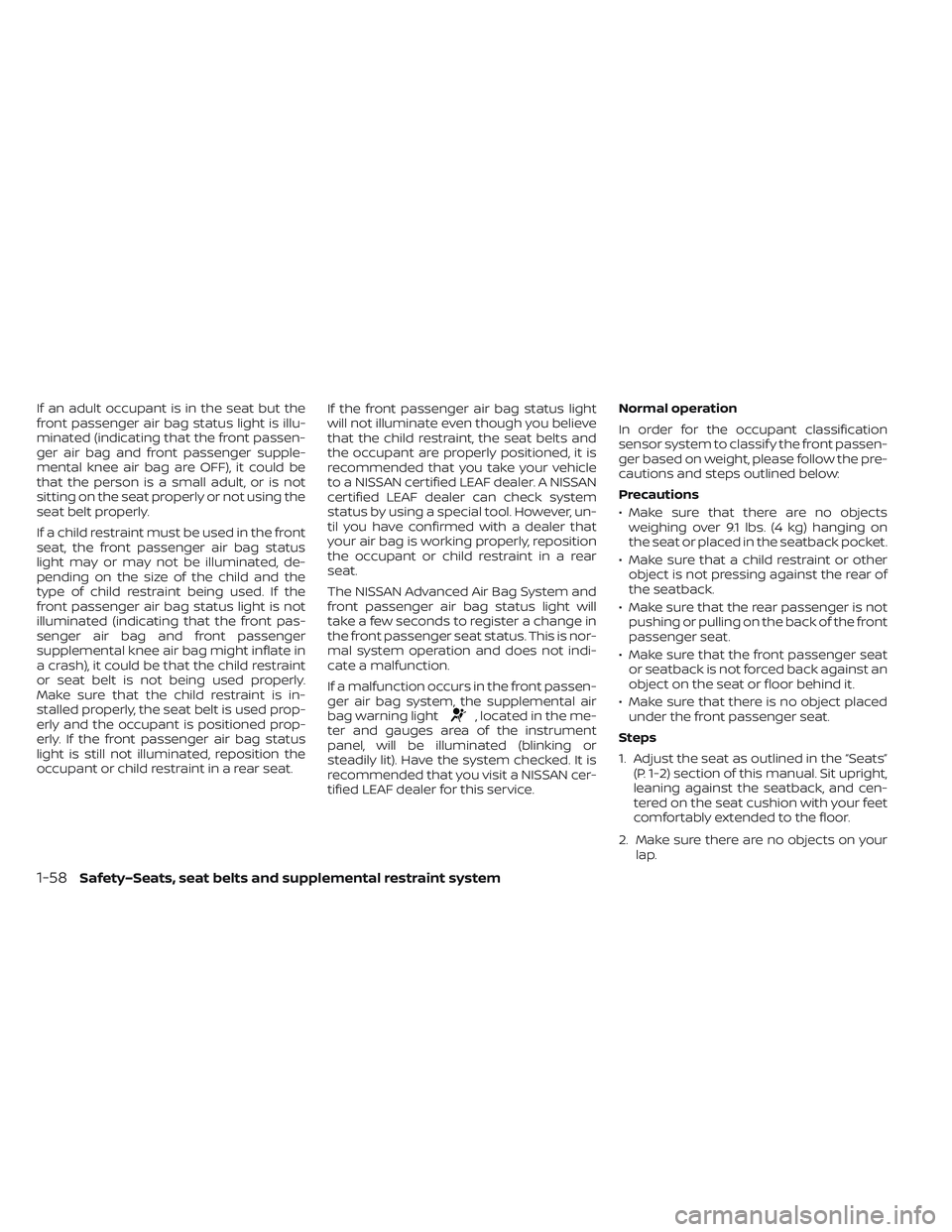
If an adult occupant is in the seat but the
front passenger air bag status light is illu-
minated (indicating that the front passen-
ger air bag and front passenger supple-
mental knee air bag are OFF), it could be
that the person is a small adult, or is not
sitting on the seat properly or not using the
seat belt properly.
If a child restraint must be used in the front
seat, the front passenger air bag status
light may or may not be illuminated, de-
pending on the size of the child and the
type of child restraint being used. If the
front passenger air bag status light is not
illuminated (indicating that the front pas-
senger air bag and front passenger
supplemental knee air bag might inflate in
a crash), it could be that the child restraint
or seat belt is not being used properly.
Make sure that the child restraint is in-
stalled properly, the seat belt is used prop-
erly and the occupant is positioned prop-
erly. If the front passenger air bag status
light is still not illuminated, reposition the
occupant or child restraint in a rear seat.If the front passenger air bag status light
will not illuminate even though you believe
that the child restraint, the seat belts and
the occupant are properly positioned, it is
recommended that you take your vehicle
to a NISSAN certified LEAF dealer. A NISSAN
certified LEAF dealer can check system
status by using a special tool. However, un-
til you have confirmed with a dealer that
your air bag is working properly, reposition
the occupant or child restraint in a rear
seat.
The NISSAN Advanced Air Bag System and
front passenger air bag status light will
take a few seconds to register a change in
the front passenger seat status. This is nor-
mal system operation and does not indi-
cate a malfunction.
If a malfunction occurs in the front passen-
ger air bag system, the supplemental air
bag warning light
, located in the me-
ter and gauges area of the instrument
panel, will be illuminated (blinking or
steadily lit). Have the system checked. It is
recommended that you visit a NISSAN cer-
tified LEAF dealer for this service. Normal operation
In order for the occupant classification
sensor system to classif y the front passen-
ger based on weight, please follow the pre-
cautions and steps outlined below:
Precautions
• Make sure that there are no objects
weighing over 9.1 lbs. (4 kg) hanging on
the seat or placed in the seatback pocket.
• Make sure that a child restraint or other object is not pressing against the rear of
the seatback.
• Make sure that the rear passenger is not pushing or pulling on the back of the front
passenger seat.
• Make sure that the front passenger seat or seatback is not forced back against an
object on the seat or floor behind it.
• Make sure that there is no object placed under the front passenger seat.
Steps
1. Adjust the seat as outlined in the “Seats” (P. 1-2) section of this manual. Sit upright,
leaning against the seatback, and cen-
tered on the seat cushion with your feet
comfortably extended to the floor.
2. Make sure there are no objects on your lap.
1-58Safety–Seats, seat belts and supplemental restraint system
Page 167 of 618
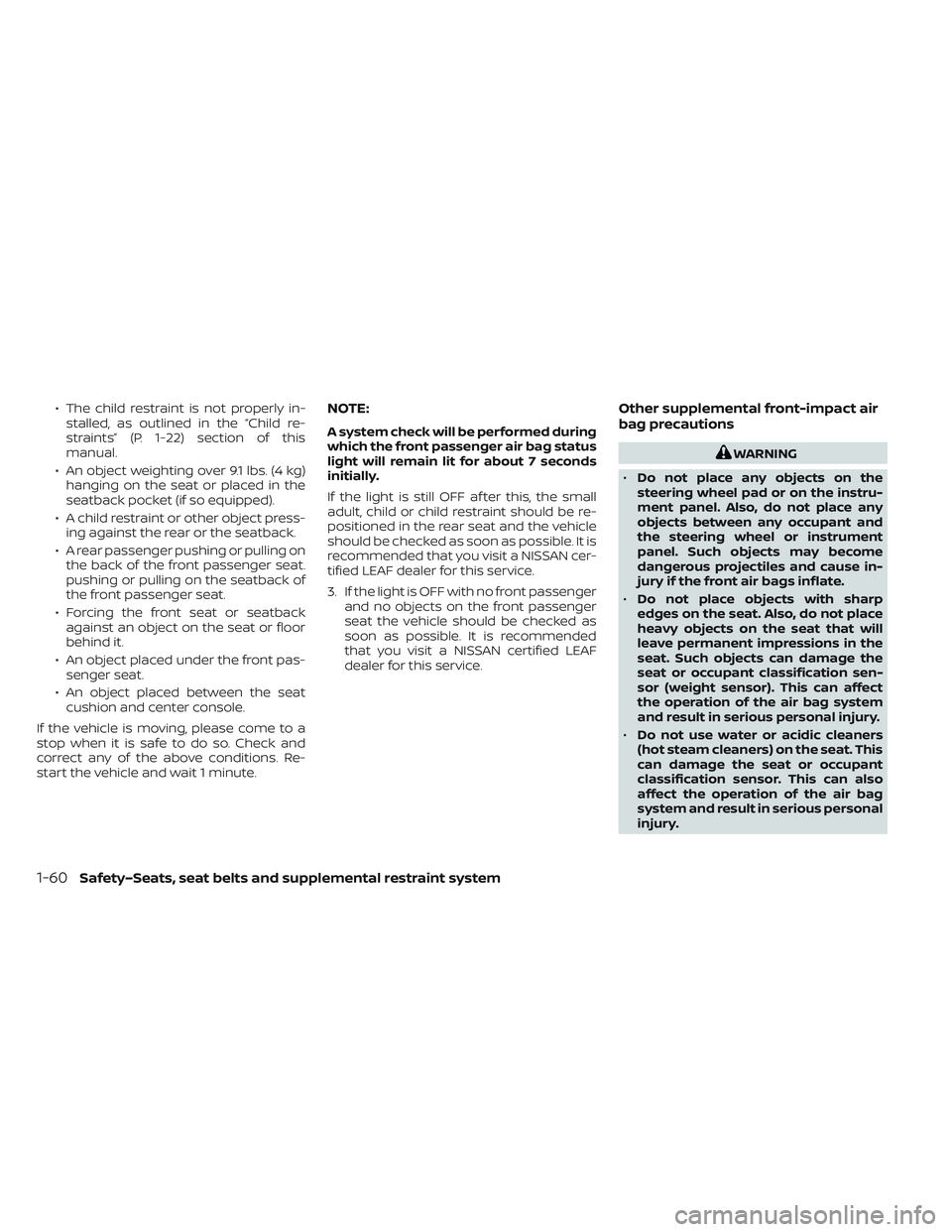
• The child restraint is not properly in-stalled, as outlined in the “Child re-
straints” (P. 1-22) section of this
manual.
• An object weighting over 9.1 lbs. (4 kg) hanging on the seat or placed in the
seatback pocket (if so equipped).
• A child restraint or other object press- ing against the rear or the seatback.
• A rear passenger pushing or pulling on the back of the front passenger seat.
pushing or pulling on the seatback of
the front passenger seat.
• Forcing the front seat or seatback against an object on the seat or floor
behind it.
• An object placed under the front pas- senger seat.
• An object placed between the seat cushion and center console.
If the vehicle is moving, please come to a
stop when it is safe to do so. Check and
correct any of the above conditions. Re-
start the vehicle and wait 1 minute.NOTE:
A system check will be performed during
which the front passenger air bag status
light will remain lit for about 7 seconds
initially.
If the light is still OFF af ter this, the small
adult, child or child restraint should be re-
positioned in the rear seat and the vehicle
should be checked as soon as possible. It is
recommended that you visit a NISSAN cer-
tified LEAF dealer for this service.
3. If the light is OFF with no front passenger and no objects on the front passenger
seat the vehicle should be checked as
soon as possible. It is recommended
that you visit a NISSAN certified LEAF
dealer for this service.
Other supplemental front-impact air
bag precautions
WARNING
• Do not place any objects on the
steering wheel pad or on the instru-
ment panel. Also, do not place any
objects between any occupant and
the steering wheel or instrument
panel. Such objects may become
dangerous projectiles and cause in-
jury if the front air bags inflate.
• Do not place objects with sharp
edges on the seat. Also, do not place
heavy objects on the seat that will
leave permanent impressions in the
seat. Such objects can damage the
seat or occupant classification sen-
sor (weight sensor). This can affect
the operation of the air bag system
and result in serious personal injury.
• Do not use water or acidic cleaners
(hot steam cleaners) on the seat. This
can damage the seat or occupant
classification sensor. This can also
affect the operation of the air bag
system and result in serious personal
injury.
1-60Safety–Seats, seat belts and supplemental restraint system
Page 169 of 618
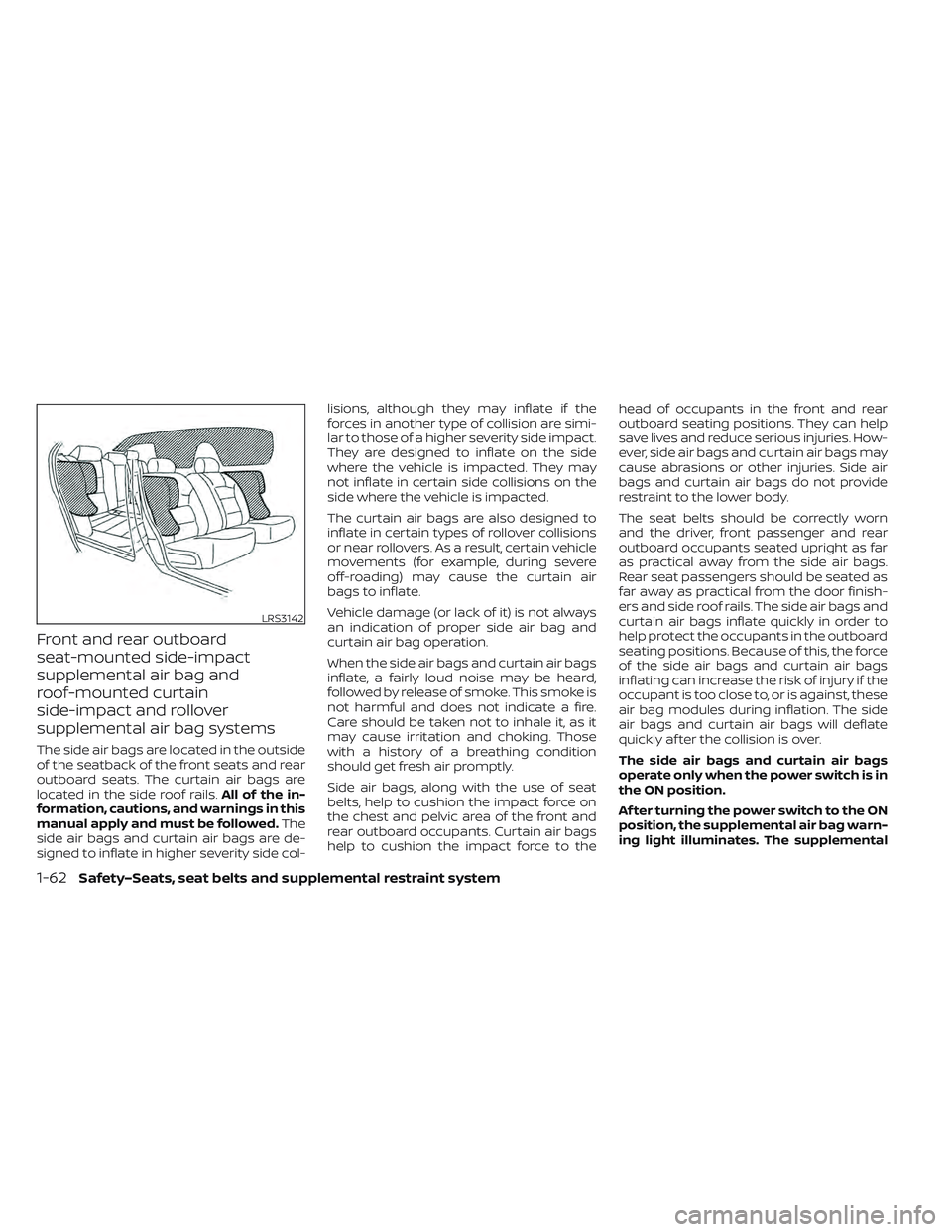
Front and rear outboard
seat-mounted side-impact
supplemental air bag and
roof-mounted curtain
side-impact and rollover
supplemental air bag systems
The side air bags are located in the outside
of the seatback of the front seats and rear
outboard seats. The curtain air bags are
located in the side roof rails.All of the in-
formation, cautions, and warnings in this
manual apply and must be followed. The
side air bags and curtain air bags are de-
signed to inflate in higher severity side col- lisions, although they may inflate if the
forces in another type of collision are simi-
lar to those of a higher severity side impact.
They are designed to inflate on the side
where the vehicle is impacted. They may
not inflate in certain side collisions on the
side where the vehicle is impacted.
The curtain air bags are also designed to
inflate in certain types of rollover collisions
or near rollovers. As a result, certain vehicle
movements (for example, during severe
off-roading) may cause the curtain air
bags to inflate.
Vehicle damage (or lack of it) is not always
an indication of proper side air bag and
curtain air bag operation.
When the side air bags and curtain air bags
inflate, a fairly loud noise may be heard,
followed by release of smoke. This smoke is
not harmful and does not indicate a fire.
Care should be taken not to inhale it, as it
may cause irritation and choking. Those
with a history of a breathing condition
should get fresh air promptly.
Side air bags, along with the use of seat
belts, help to cushion the impact force on
the chest and pelvic area of the front and
rear outboard occupants. Curtain air bags
help to cushion the impact force to the
head of occupants in the front and rear
outboard seating positions. They can help
save lives and reduce serious injuries. How-
ever, side air bags and curtain air bags may
cause abrasions or other injuries. Side air
bags and curtain air bags do not provide
restraint to the lower body.
The seat belts should be correctly worn
and the driver, front passenger and rear
outboard occupants seated upright as far
as practical away from the side air bags.
Rear seat passengers should be seated as
far away as practical from the door finish-
ers and side roof rails. The side air bags and
curtain air bags inflate quickly in order to
help protect the occupants in the outboard
seating positions. Because of this, the force
of the side air bags and curtain air bags
inflating can increase the risk of injury if the
occupant is too close to, or is against, these
air bag modules during inflation. The side
air bags and curtain air bags will deflate
quickly af ter the collision is over.
The side air bags and curtain air bags
operate only when the power switch is in
the ON position.
Af ter turning the power switch to the ON
position, the supplemental air bag warn-
ing light illuminates. The supplemental
LRS3142
1-62Safety–Seats, seat belts and supplemental restraint system